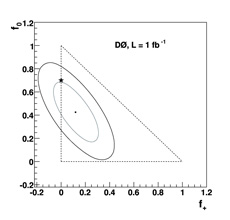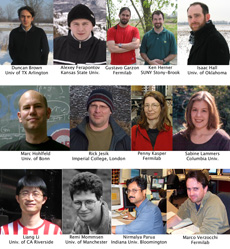Getting answers from the W Boson
 |
| The W boson helicity fractions in top quark decays that are the best match to the data are shown by the dot in this figure. Helicity refers to the relationship between a particle's "spin" and momentum when it is in motion. The smaller and larger ellipses contain the values consistent with the data at 68 percent and 95 percent confidence levels, respectively. The star marks the Standard Model predictions, and the triangle bounds the physically-allowed values.
|
 |
| DZero collaborators from the University of Arizona designed this measurement of W boson helicity in top quark decays.
|
 |
| Members of the DZero Trigger Board work to ensure the data taken at DZero reflects a broad range of physics interests while selecting interesting events with the highest possible efficiencies. Their efforts are essential for analyses such as that shown here.
|
Since the discovery of the top quark, physicists have been scrutinizing every detail of this heavyweight particle. The attention comes with good reason, as the top quark guards many secrets of our universe, from hints about the Higgs boson to insight on electroweak interactions. However, the top quark decays almost immediately after it is produced, leaving little time to study it. Tevatron researchers generally reconstruct the top quark's last moments via its decay particles: a W boson and a bottom quark. Though this CSI-style technique yields much information on what happened, it doesn't tell the full story. Physicists at the DZero experiment are taking this detective work one step farther by getting answers directly from the W boson.
When top quarks decay, they must follow rules laid out by quantum mechanics. Those rules govern features of the decay products such as the energy, electric charge, and a quantum number known as "spin." The historical terminology of "spin" refers to an intrinsic property that has nothing to do with the particle's motion.
When a particle is in motion, the relationship between its "spin" and momentum is referred to as its helicity. If a passenger on a moving train represented a particle's spin, the helicity would be determined by which direction the passenger faced: forward gives positive helicity and backward gives negative helicity. A third option comes from passengers looking out the window transverse to the train's path, or zero helicity. In top quark decays, the W boson daughter particle must choose one of the three helicity modes and theories predict the average fraction of each. The Standard Model predicts that the W boson in top quark decays should have a positive helicity fraction (f+) of 0.036 percent and a zero helicity fraction (f0) of 70 percent. A departure from these values would indicate physics beyond the Standard Model.
The DZero detectives have, for the first time, expanded their dragnet of W boson suspects to include those that decay to two quarks. By including these events with the lepton plus neutrino decays, they are also able to publish the first model-independent measurement of W boson helicity in top quark decays. In one inverse femtobarn of data, the DZero researchers analyzed 363 top-pair events and measured the W boson helicity in each top quark decay. Their data indicates a fraction of zero helicity (f0) of 43 ± 20 percent and a fraction of positive helicity (f+) of 12 ± 10 percent. This result is compatible with the Standard Model at a level of 30 percent and it is clear these sleuths are closing in on their answer. As data continues to pour in, DZero physicists will be keeping the heat on W bosons as their investigation gets closer to the truth about the top quark.
Learn more here and here.
Result of the Week Archive
|